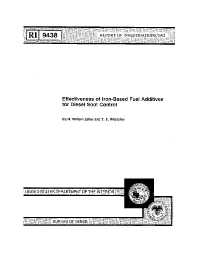Mining Publication: Effectiveness of Iron-Based Fuel Additives for Diesel Soot Control
Original creation date: January 1992
The U.S. Bureau of Mines (Bureau), evaluated the effects of two iron-based fuel additives on diesel particulate matter (DPM) emissions. The 5.6-L, 6-cylinder test engine is typical of types used in underground mines. One additive, ferrous picrate, lacked measurable effects on exhaust emissions. The report is mainly about a ferrocene-based additive that reduced DPM between 4 and 45 pct, depending on engine operating conditions. The report concludes that the DPM reductions were caused by the catalytic oxidation properties of a ferric oxide coating developed inside the engine's combustion chamber. The ferric oxide coating also decreased gas-phase hydrocarbons and O2, but increased CO2 and NOX. The increased NOX, of about 12 pct, is considered the only adverse effect of the ferrocene-based fuel additive. The results suggest that the effectiveness of ferrocene was partially offset by increased sulfates because of the high-sulfur fuel used. Recommendations for continuing fuel additive research are presented.
Authors: HW Zeller, TE Westphal
Report of Investigations - January 1992
NIOSHTIC2 Number: 10011464
Minneapolis, MN: U.S. Department of the Interior, Bureau of Mines, RI-9438, 1992 Jan; :1-26
See Also
- Aerosols Emitted in Underground Mine Air by Diesel Engine Fueled with Biodiesel
- AQE - Air Quantity Estimator - 1.0.3
- A Computer Software Program that Estimates Air Quantity Requirements in Large Opening Stone Mines
- Effects of Diesel Exhaust Aftertreatment Devices on Concentrations and Size Distribution of Aerosols in Underground Mine Air
- The Effects of Water Emulsified Fuel on Diesel Particulate Matter Concentrations in Underground Mines
- Emissions from a Diesel Engine using Fe-based Fuel Additives and a Sintered Metal Filtration System
- The Fate of Metal (Fe) During Diesel Combustion: Morphology, Chemistry, and Formation Pathways of Nanoparticles
- Mutagenicity of Diesel Exhaust Particles from an Engine with Differing Exhaust After Treatments
- Technology News 514 - The Air Quantity Estimator (AQE): A New Computer Software Tool for Large-opening Mine Ventilation Planning
- Thermal Stability of ANFO Made with Recycled Oil
- Content source: National Institute for Occupational Safety and Health, Mining Program


 ShareCompartir
ShareCompartir
